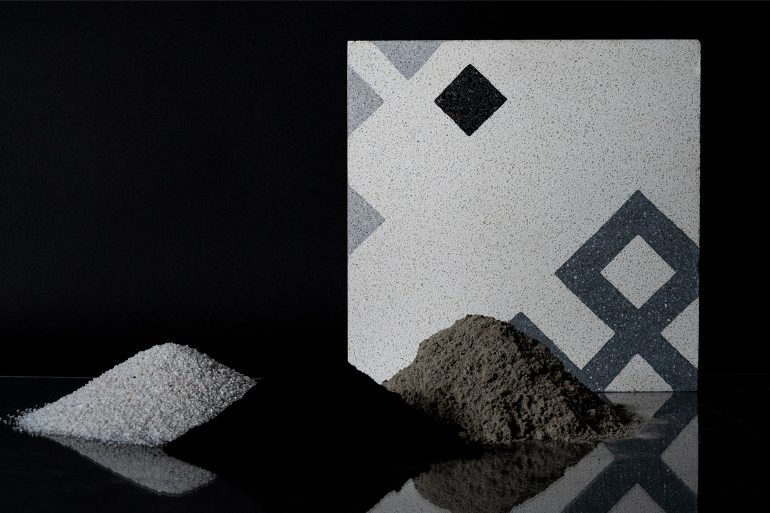This article is second in the Alchemist series on material researchers. Tejas Sidnal is one of the winners of the No Waste Challenge, What Design Can Do’s third Climate Action Challenge in partnership with the IKEA Foundation. Launched in January 2021, the design competition called for bold solutions to reduce waste and rethink our entire production and consumption cycle.

The quest for three basic human needs—clean air, clean water, and clean food—fueled the research and innovation at Carbon Craft Design, a Goa-based design studio. Tejas Sidnal, the founder, had always been excited about mimicking the strategies of nature in his design solutions. Well versed in material science, biomimicry and computational design, his current work focuses on harnessing air pollution to create carbon tiles.
Having worked as an architect for a few years, Sidnal was disappointed with his profession’s huge contributing to air pollution.
Today, 39% of global energy-related carbon emissions are attributed to buildings. Having worked as an architect for a few years, Sidnal was disappointed with his profession’s huge contributing to air pollution. He sought to bring his academic-based research into the real world where it could make a difference, building architecture that enabled clean air, water and food. Enter Carbon Craft Design, a creative start-up that upcycles carbon through the fusion of high-tech practices and low-tech craftsmanship.

“Take a look around yourself, can you see anything that’s black?” Sidnal asks. The black color of phone screens, tires, and rubbers is obtained from a byproduct of burnt fossil fuel, called carbon black. This waste material is produced in tons and is usually dumped or further burnt away, significantly contributing to air pollution. It is this waste material, carbon black, that Carbon Craft Design currently uses in their products, filling the gap in the industry for low carbon-intensive products.

Trying to find applications of the material, the team came up with prototypes of bricks, facade elements, and finally, tiles. While research and precedents proved the feasibility of bricks, the product was not something that would sell as it lacked aesthetic value. An alternative that they arrived at then was a facade element – it had the design factor, but wasn’t commercially scalable. Then came the inspiration to make tiles out of carbon. The tiles would narrate a story with its handcrafted art form and would be scalable as it has a variety of uses. The tile industry in India hasn’t evolved in decades, greasing the wheels for a novel product to enter the market.
The artisans could intuitively sense that the material would not work as a tile, sending the R&D team back to the drawing board.
The experimental design practice carefully amalgamates a 200-year old traditional craft with cutting edge material science. Collaborating with artisans at Morbi, Gujarat—the 2nd largest tile production cluster in the world—Sidnal and his team pivoted on generational knowledge to create tiles that respect nature.

Carbon Craft Design was excellent with their material innovation, and the artisans with their craft. Finding a balance between both was tricky, but led to better understanding and cooperation between both parties. The artisans could intuitively sense that the material would not work as a tile, sending the R&D team back to the drawing board. They also helped shape the design perspective, educating the start-up on what would and wouldn’t be possible. The partnership taught Sidnal how they could work with various mixes and base materials to create more feasibly designed products.
Material is the core component of design and will be the defining element of what makes design sustainable.
Sidnal recognizes the huge opportunity in working with artisans and traditional crafts. The handicraft industry is the second-largest livelihood provider in India. “We have the people, the skill sets, and the infrastructure. All we need is the right fusion of technology and material to be superior leaders in the fight against climate change,” he states. Material is the core component of design and will be the defining element of what makes design sustainable. While handcrafted techniques and systems can remain the same, the material that artisans use needs critical analysis and change.

Carbon Craft Design aspires to employ 1000 happy artisans. They also envision transferring their knowledge to different states and countries. Sidnal shares, “We imagine the artisans as craft warriors; as climate warriors. It becomes a craft against climate change.”
The architect has also been experimenting with carbon in local block printing techniques. With their material, they can move into printing or packaging, and any product that needs black pigments. They are also working with carbon-di-oxide, which will be used to cure the tiles and be stored within the tile itself.
***
Ankitha Gattupalli is an architect and active contributor to discourse on spatial practices. Her work aims to uncover and reshape the processes through which spaces, ecologies and communities are collectively created. This article is second in the Alchemist series on material researchers and biomaterials. Gattupalli previously wrote about material designer Sachi Tungare, who created a new material out of marigolds. Read here.

